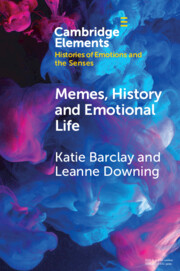Element contents
Memes, History and Emotional Life
Published online by Cambridge University Press: 16 June 2023
Summary
Keywords
- Type
- Element
- Information
- Online ISBN: 9781009063715Publisher: Cambridge University PressPrint publication: 13 July 2023
References
- 7
- Cited by

